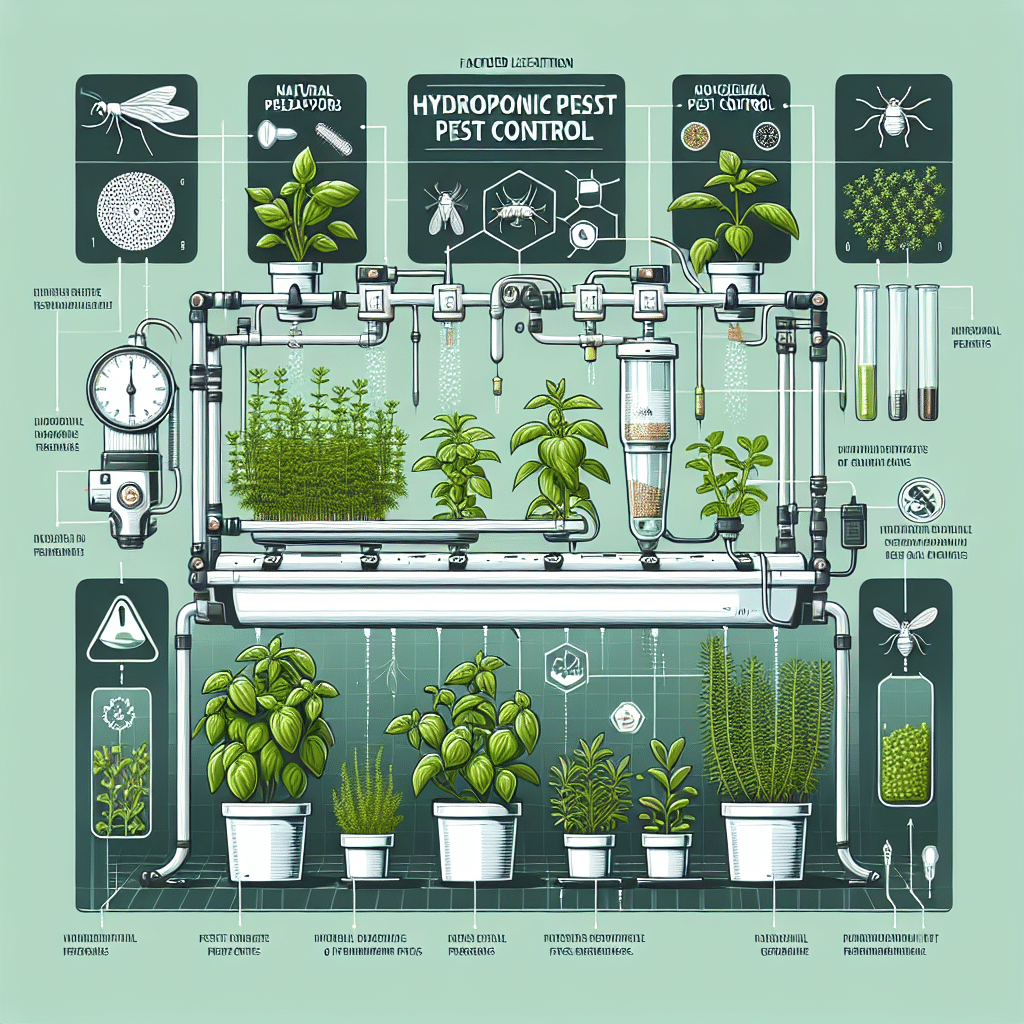Understanding Hydroponic Pest Control for Herbs
1. The Basics of Hydroponics
Hydroponics is a method of growing plants without soil, utilizing nutrient-rich water solutions to nourish plants. This technique is particularly popular for growing herbs such as basil, mint, and cilantro. As hydroponic systems typically offer ideal growing conditions, they can inadvertently attract pests that may jeopardize your herb garden’s health.
2. Common Pests in Hydroponics
Identifying pests early is crucial for effective control. Common pests affecting hydroponic herbs include:
- Aphids: Small, green or black insects that feed on plant sap, leading to stunted growth and fungal disease.
- Spider Mites: Microscopic pests that cause yellowing and speckling on leaves by sucking cell contents.
- Whiteflies: Small white insects that thrive on the undersides of leaves, excreting honeydew, leading to sooty mold.
- Thrips: Tiny, slender insects that can cause discoloration and scarring on leaves.
- Fungus Gnats: Larvae live in the growing medium and can damage roots.
3. Preventive Measures
3.1. Cleanliness
Maintaining a clean growing environment is key. Rivers prone to pest infestations should implement stringent cleaning protocols:
- Sanitize equipment before use.
- Remove dead plant material and debris regularly.
- Use sterile tools for pruning and harvesting.
3.2. Environmental Control
Pests thrive in certain conditions. Adjusting environmental factors can deter them:
- Humidity: Maintain humidity levels between 50-70%. Excess humidity can encourage pests.
- Temperature: Keep the growing area at optimal temperatures (65°F to 75°F during the day).
- Air Circulation: Good airflow reduces humidity and makes it difficult for pests to settle. Consider using fans to enhance air circulation.
3.3. Companion Planting
Certain plants can act as pest repellents. Integrating companion plants can discourage pest populations:
- Basil: Serves as a natural repellent to whiteflies and mosquitoes.
- Nasturtium: Attracts aphids away from more vulnerable herbs.
4. Integrated Pest Management (IPM)
IPM combines various management practices for sustainable pest control. Key strategies include:
- Monitoring: Regularly inspect plants for early signs of pests. Use sticky traps to track insect populations.
- Threshold Levels: Establish acceptable pest levels. Not all pests require immediate action; identify which are economically damaging.
5. Biological Control
Encourage beneficial organisms that prey on harmful pests:
- Ladybugs: Effective against aphids and can be introduced into the hydroponic environment.
- Predatory Mites: Feed on spider mites and can significantly reduce populations.
6. Chemical Control Options
When pests exceed control levels, chemical treatments may be necessary. Opt for organic or least-toxic solutions:
- Neem Oil: Extracted from the seeds of the neem tree. It disrupts pest life cycles and acts as a repellent.
- Insecticidal Soap: Effective against soft-bodied insects like aphids and spider mites. It suffocates pests on contact.
- Pyrethrin: A natural insecticide derived from chrysanthemum flowers. Caution is required, as it can also harm beneficial insects.
7. Organic Solutions and Homemade Remedies
Crafting homemade solutions can offer effective pest control without harsh chemicals:
- Garlic Spray: Blend garlic with water, strain, and use as a spray. The strong odor deters pests effectively.
- Pepper Spray: Mix hot pepper flakes or cayenne powder with water and spray on affected plants.
- Diatomaceous Earth: A natural powder that damages the exoskeletons of insects upon contact.
8. Regular Maintenance and Monitoring
Establish a routine for monitoring your herbs:
- Weekly Inspections: Examine leaves, stems, and undersides for signs of pests.
- Record Keeping: Maintain a log of pest sightings and interventions, improving future pest management strategies.
9. Pest Resistance Strategies
Promote plant health to increase resistance to pests:
- Proper Nutrition: Ensure nutrient-balanced water solutions. Deficiencies can weaken plants, making them more susceptible to pests.
- Diversity: Grow a variety of herbs to create a balanced ecosystem that can fend off pests naturally.
10. Pesticide Safety Guidelines
If utilizing chemical pesticides, adhere to safety protocols:
- Follow Instructions: Always read labels and follow guidelines for application rates, intervals, and safety precautions.
- Protect Yourself: Wear gloves, masks, and goggles during application to prevent exposure.
- Avoid Contamination: Ensure pesticide application doesn’t affect water sources or non-target plants.
11. Considerations for Hydroponic Systems
Hydroponics in greenhouses or indoors may require additional caution:
- Isolation: Prevent pest spread by isolating new plants for a few weeks before integrating them into the existing system.
- Water Management: Keep reservoir water at the correct pH and nutrient levels to enhance plant vitality and resilience against pests.
12. The Role of Technology in Pest Management
Innovative technology can enhance pest control in hydroponics:
- Smart Sensors: Deploy sensors to monitor humidity, temperature, and light, reducing ideal conditions for pest proliferation.
- Drones and Cameras: Utilize drones for aerial monitoring, providing a comprehensive view of pest hotspots in larger setups.
13. Educating Yourself and Others
Stay informed about pest management techniques and share knowledge within gardening communities:
- Workshops: Attend local or online workshops on hydroponic pest control.
- Online Forums: Join online discussions to share experiences, solutions, and strategies with fellow growers.
14. Legal and Environmental Considerations
Understand the implications of pesticide use in hydroponics:
- Local Regulations: Be aware of pesticide regulations in your area, particularly for edible plants.
- Impact on Biodiversity: Consider the environmental impact when selecting pest control methods and strive for sustainable practices.
Efforts in hydroponic pest control for herbs demand vigilance, timely intervention, and a commitment to best practices. Combining preventive measures, biological controls, organic solutions, and technology, you can create a resilient hydroponic ecosystem that thrives without the disruptive influence of pests. Embrace continuous learning and adapt your strategies to cultivate healthy, vibrant herbs in your hydroponic garden.
